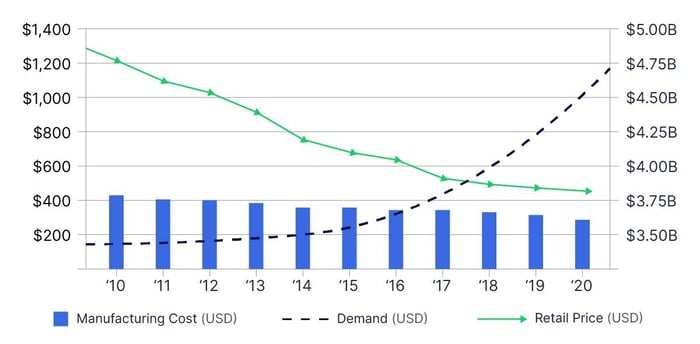How Userful Lowers Total Cost of Ownership TCO
The Leading Provider of AV as a Service (AVaaS)

A Competitive Cost-Analysis of Enterprise Display Deployments
Total Cost of Ownership or TCO is a detailed estimation of direct and indirect costs of a project or product for the entirety of its lifetime.
The phenomenon is most applicable to organizations that invest large amounts of time, resources, and money on their corporate infrastructure, operations and business tools. While our daily personal purchases or even individually owned technology can be evaluated on basis of their upfront costs, organizations have to consider accumulating, indirect, or operational costs of their infrastructure that can exponentially increase over time.
As growth of an organization is achieved by maximizing resource efficiency while minimizing costs and time constraints, TCO is a vital framework for assessing the true cost of any enterprise-level deployment.
As a leading provider of cost-effective digital displays and video wall applications, we'd like to share key cost considerations for any buyer preparing to invest in a display solution. We'll specifically address 3 areas of enterprise display technology where TCO considerations are most critical:
- Video Walls for Control Centers
- Direct-view LED for Operations
- Mission-Critical Digital Signage
Acquisition costs and Operating costs
Regardless of the video wall or digital display provider being used, buyers continue to benefit from newer, more efficient, and more powerful options for digital display screens at comparatively lower costs.
As the demand of visual applications grows and digital displays become increasingly ubiquitous across all industries, there have been steady improvements in hardware production, research and development, and technology of LED and LCD displays. This has ultimately lowered manufacturing costs of screens (per pixel) and competitive pricing.

In simpler terms, effectively all buyers of enterprise-level digital displays are at a net advantage in purchasing digital display screens and mounting equipment—that remain consistently if not increasingly cost-effective across the board.
However, networking hardware, electric infrastructure and labor costs, implementation of management, security, and maintenance tools, and training for both IT and end-users also factor into true acquisition cost of a digital display installation and should be metricized when evaluating an investment.
On the other hand, operational costs include software and hardware support, any contingent hardware's lifecycle and replacement, power consumption, and costs to the organization during total downtime due to system failures, scheduled maintenance, debugging, and any upgrades during the deployment's lifespan.
While most acquiring organizations don't think about the end-of-life stages when looking into future projects, it is imperative for organizations to be mindful of costs for upgrading, scaling, or replacing their deployments. This is because manufacturers can create strong vendor lock-in at the expense of the buyer. Especially with proprietary hardware-based projects that consume time and energy to install and replace, providers can charge high premiums for even simple upgrades and replacements over time. This is why technology acquired on perpetual terms is often not a one-time transaction, but in fact one that continues and even grows over time.
Vendor Lock-In: Hardware costs of Proprietary vs COTS
Vendor lock-in results from the purchase of a closed system that limits customer choice of add-ons, replacement parts, or upgrades to a single or select vendors.
With the ever-plummeting cost of screen/display hardware, many manufacturers have scaled their efforts at creating vendor lock-in to safeguard profit. While buyers are spoiled for options of screens based on their exact use-case and project requirements, they should opt for Commercial Off-the-Shelf (COTs) hardware that limits their reliance on specific hardware providers. In fact, organizations should discourage use of proprietary hardware and legacy applications, and opt for devices that will remain easy to replace, upgrade, and scale.
One of Userful's most distinct TCO advantages is its use of COTS hardware. Userful's customers can purchase a PC/Server from established global brands such as Lenovo, HP and Dell. This leverages economies of scale to reduce costs, ensures global availability, and when it comes to ongoing costs it also delivers a sizable reduction in TCO by leveraging existing global support infrastructure for replacement parts and any service that might be needed.
By virtue of being relatively niche to mid-large-sized corporations, many video wall controllers and processors are built on specialized black box hardware. In fact, many of the supposedly "AV-over-IP solutions" that have emerged in recent years to deploy AV applications and services over the network are also closed, proprietary systems, without interoperability or compatibility with integrations, alternate options, or different providers. For example, if a customer purchases AV encoders and decoders from a leading vendor today, there is no guarantee that a year from now the vendor's next-generation encoders and decoders will be backward compatible, and there is certainly no guarantee they can be switched with another hardware-based competitor. Additionally, the longer a deployment is kept, the more difficult and expensive it becomes to find and replace its constituent components, parts, and technical support. This way, many organizations are at the risk of being confined to a cycle of vendor lock-in that not only increases TCO but limits their ability to expand over time.
Userful's use of commercially-available-off-the-shelf hardware from companies such as HP, Lenovo, and Dell practically ensures readily available and cost-effective hardware, support, expertise, and technical resources from both in-house and third part IT professionals, and flexibility for organizations to integrate, customize, and upgrade their deployments at minimal TCO and vendor lock-in over time. In fact, the subsequent time, resources, and budget can and should be reinvested into other areas for the growth and efficiency of the organization.
To learn how Userful compares with competitors in total costs of ownership, Download our Free White Paper on TCO of Enterprise-Level Display Applications.
Training, Support, and Maintenance
A major competitive advantage of Userful is that it is easy for IT departments to support, throughout its initiation and lifespan. The standard commercially available-off-the-shelf hardware, IP protocols, and browser-based control interface are familiar to any IT or tech support team.
In terms of administration, it's easily managed either through a simple cloud interface or directly on its PC/server. The Operating System CentOS—bit for bit Red Hat Enterprise—can be integrated with existing server management protocols, and practices, and security measures.
Userful customers in need of support are able to allow Userful support staff to remotely access their server ensuring better response times when issues do arise. To further reduce the risk of downtime, any Userful deployment with an on-premise server can have a second failover server for the cost of a second PC/Server. The software is set to automatically switch to the backup PC/server in the unlikely event of a hardware failure. Because every Userful purchase comes with Gold support, a Userful representative is only an email or phone call away. In contrast, solutions that use proprietary AV hardware or proprietary AV-over-IP protocols are not familiar to most IT departments and do not necessarily follow IT standards, nor can they always be diagnosed by any singular support team. As a result, learning curves for end-users and IT administrators are both steeper and costly.
In terms of ease of use, Userful's customers consistently rate the product high for ease of use and installation. On review aggregator, G2 Userful has a score of 8.6/10 for ease of use. In a recent customer survey, 85.7% of respondents say that Userful is "easy or very easy" to deploy and use. This results in a measurably lower installation, training, and management costs over time.
Takeaway: the Cost-Driven Consideration
Ultimately, Userful's long-term advantage is that it's a software-driven platform—not a point solution. While many customers first purchase Userful to address their need or use-case for a video wall in a control and operations center, they are also able to use the very same platform to enable digital signage in their receptions and production facilitation, televisions in lounges, corporate communication displays in conference rooms, and so much more. Userful's ability to bridge the individual AV silos created by a series of point solutions ensures ongoing TCO savings to the organization.
Userful: the software-based solution
Userful is a leading provider of visual applications, with customers encompassing a broad range of mission-critical organizations—including NASA, American Red Cross, United Nations, Jefferson County 911, SpearTip, and others. Our award-winning Visual Networking Platform is a single software tool for large and security-driven organizations to manage their display infrastructure across numerous locations worldwide.
Our software and browser-based platform for EOCs allows operators drag-and-drop tools to (re)configure their dashboards, reports, data feeds—across virtually any digital display, including video walls, digital signage, kiosks, and public computers—enabling enterprise-level analysis, reporting, and collaboration capabilities.
Learn how Userful's software solution can reduce the total cost of deploying your Emergency Operations Center by up to 40% by booking a free consultation from one of our experts.
Userful
The Leading Provider of AV as a Service (AVaaS)